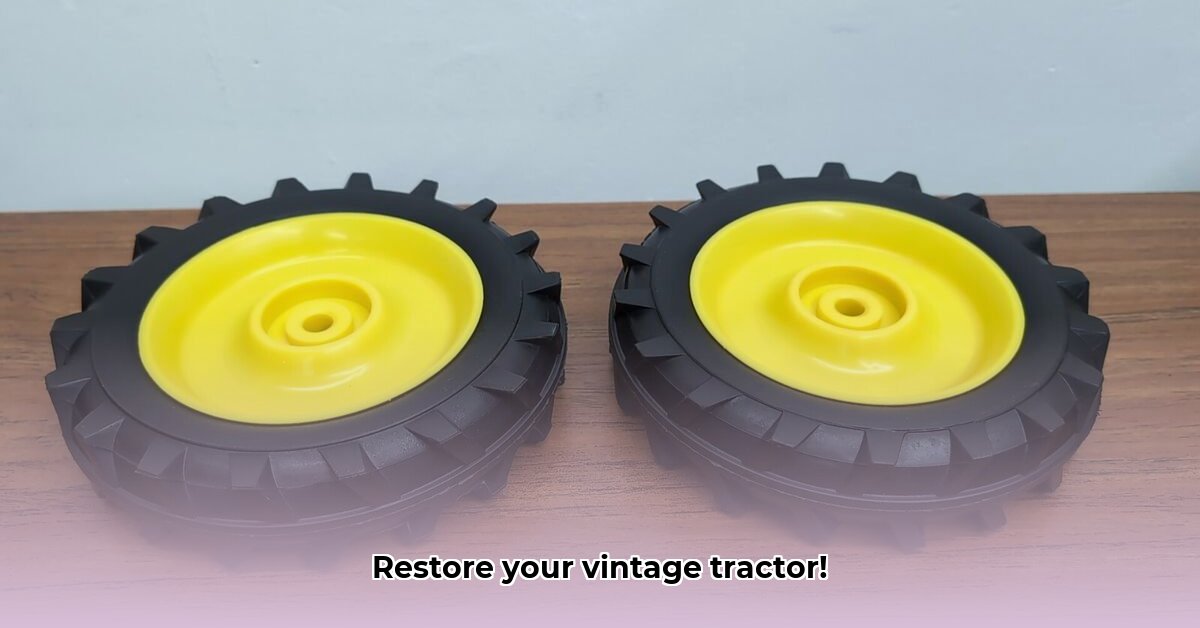
Pedal Tractor Parts: Your Journey to Restoration Glory
Remember the thrill of pushing your pedal tractor across the yard, the sun warming your face, the wind in your hair? Reliving that childhood magic is entirely possible. Unearthing the perfect parts to restore your vintage tractor can be a challenging treasure hunt, but with the right knowledge and resources, it becomes an immensely rewarding experience. This guide will empower you, equipping you with the skills and confidence to bring your beloved machine back to life. For even more resources, check out this helpful site: Deere Pedal Tractors.
Identifying Your Little Workhorse: Knowing Your Tractor
Before embarking on your restoration quest, you must identify your tractor's make, model, and year. This crucial step unlocks the key to finding the correct parts. Start by meticulously examining your tractor for markings, often etched into the metal frame or hidden beneath the hood. Look for a manufacturer's plate or a serial number – these are your vital clues. High-resolution photographs taken from multiple angles will greatly assist in identification. Online forums dedicated to vintage toys and pedal tractors are invaluable resources; fellow enthusiasts are always ready to share their expertise. Don’t hesitate to ask for help! A simple photo might be all it takes to unlock your tractor's identity and pave the way for a successful restoration.
The Great Pedal Tractor Parts Hunt: Sourcing Your Treasures
Now begins the exciting (and sometimes challenging) hunt! Let's explore effective strategies for locating those elusive parts.
Online Marketplaces: Websites specializing in vintage toys and antique parts offer a vast selection. However, prices and availability vary drastically; diligent comparison shopping is essential. Set a realistic budget and stick to it.
Auction Adventures: Auction sites are potential treasure troves, but be warned: auctions can be highly competitive. Always set a maximum bidding price and avoid getting caught up in the excitement.
Flea Markets and Swap Meets: These events offer an immersive experience. You can inspect parts firsthand and assess their condition. Be prepared for a thorough search; finding the right piece often requires patience and persistence.
Connecting with Collectors: Engage with the passionate community of vintage toy collectors. Many have amassed impressive collections of spare parts. Networking within these communities can unveil hidden gems and valuable connections. Don't underestimate the power of networking—a fellow collector might just have the missing piece you've been searching for! Are you ready to join this vibrant community and collaborate with fellow enthusiasts?
Pedal Tractor Restoration: Hands-On Healing
Restoration is a journey, not a race. Take your time, enjoy the process, and celebrate each milestone.
Preparation: The Foundation of Success: Before any repairs, thoroughly clean the part. Remove dirt, grime, and rust to accurately assess the damage and ensure successful repair. This crucial step sets the stage for a smooth restoration process.
Start Small, Build Momentum: Begin with small, less complex repairs to build confidence and experience. Addressing minor issues first provides a sense of accomplishment and fuels motivation for tackling more challenging repairs.
Documentation: Your Restoration Record: Document your progress with photos and notes. This helps track your work, solve problems, and serves as a valuable reference for future projects. A well-documented restoration is a successful restoration.
Your Restoration Toolkit: Gathering Your Arsenal
Having the right tools ensures safe and efficient repairs.
| Tool | Purpose |
|---|---|
| Screwdrivers (various sizes) | Loosening and tightening screws. |
| Wrenches (various sizes) | Removing and installing nuts and bolts. |
| Needle-nose pliers | Gripping and manipulating small parts. |
| Rubber mallet | Gentle tapping during assembly. |
| Wire brush | Removing surface rust and dirt. |
| Protective Gear (Safety glasses, gloves) | Essential for safety. |
Troubleshooting Troubles: Common Challenges and Solutions
Even seasoned restorers encounter problems. Here are some common issues and solutions:
- Broken Wheels: Repair may be possible; otherwise, sourcing a replacement might be necessary.
- Missing or Damaged Decals: Repro decals are often available online.
- Rust and Corrosion: Address surface rust with a wire brush; significant corrosion might require part replacement. Is your tractor showing signs of significant rust? Addressing this early is critical for preventing further damage.
The Power of Community: Connecting with Fellow Enthusiasts
Don't work alone! Join online forums and clubs dedicated to antique pedal tractors. These communities offer invaluable support, knowledge-sharing, and camaraderie. Connecting with fellow enthusiasts can transform a challenging project into a rewarding shared experience. Are you ready to tap into the collective wisdom of a passionate community?
Remember, restoring your pedal tractor is a blend of skillful repair, patient persistence, and a hearty dose of fun! Embrace the challenges, savor the victories, and enjoy the journey!